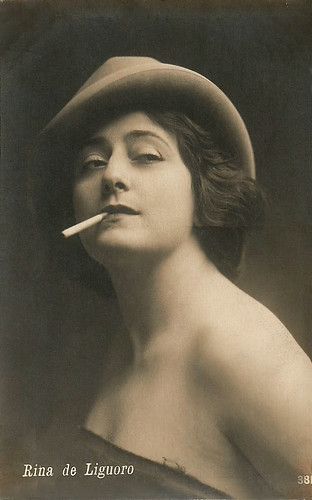
Italian postcard by Ballerini & Fratini, Firenze, no. 381.
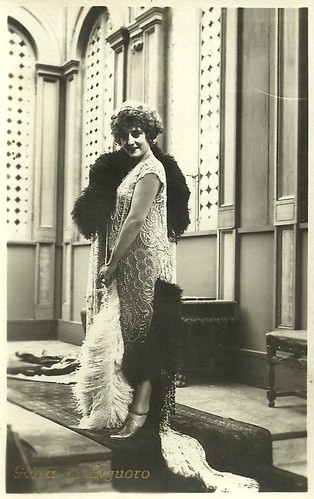
Italian postcard by Ed. G.B. Falci, Milano, no. 475.
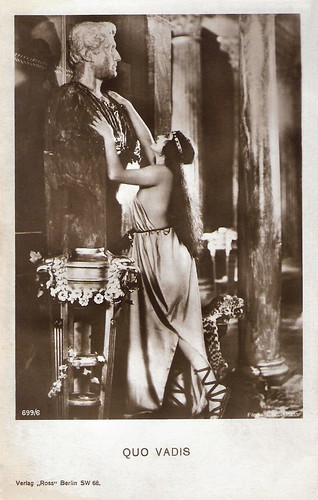
German postcard by Ross-Verlag, Berlin, no. 699/6,1919-1924. Photo: Filmhaus Brückmann. Rina De Liguoro in Quo Vadis? (Gabriellino D'Annunzio, Georg Jacoby, 1924).
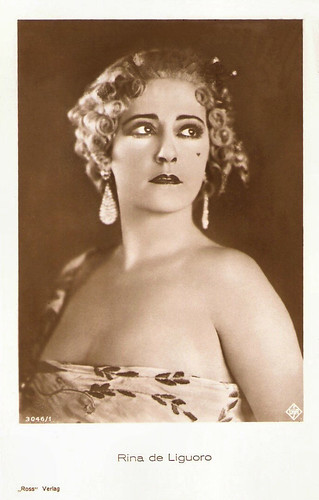
German postcard by Ross Verlag, no. 3046/1, 1928-1929. Photo: Ufa.

German postcard by Ross Verlag, no. 3902/1, 1928-1929. Photo: Pinto Roma.

French postcard by Editions Cinémagazine, no. 431. Photo: Studio G.L. Manuel Frères.
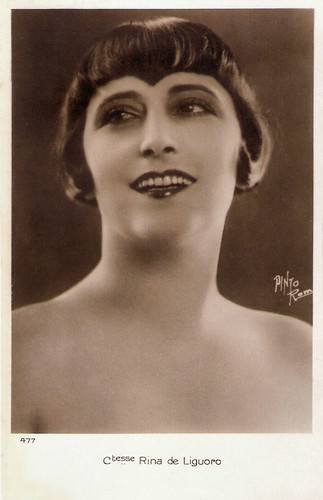
French postcard by Cinémagazine-Edition, Paris, no. 477. Photo: Pinto, Roma. The card refers to her status as a countess.
Messalina
Rina De Liguoro was born as Elisabetta Caterina Catardi in Firenze (Florence), Italy, in 1892. She studied piano with Maestro Luigi Finizio, graduating at the Conservatory of San Pietro a Majella in Naples. She made her debut as a pianist at the age of twenty-five and soon became a valued concert performer.
In 1918, she married Count Wladimiro De Liguoro, son of film director and producer Giuseppe De Liguoro. They had a daughter, Regana, born the following year. Later, Wladimiro De Liguoro would direct several of her films. After a concert in 1920, Rina was invited to visit a film set. During this visit, she appeared as an extra in La Principessa Bebé/The Princess Baby (Lucio D'Ambra, 1920). This was the start of a prolific film career.
She had her breakthrough with the lead role in the historical epic Messalina/The Fall of an Empress (Enrico Guazzoni, 1924), in which she played the sensual, untamed third wife of the Roman Emperor Claudius. De Liguoro became the last diva of the Italian silent cinema with notable films like Quo vadis? (Gabriellino D'Annunzio, Georg Jacoby, 1924) also starring Emil Jannings, Elena Sangro and Lillian Hall-Davis, and Gli ultimi giorni di Pompeii/The Last Days of Pompeii (Carmine Gallone, Amleto Palermi, 1926) with Victor Varconi and Maria Corda. There were several attempts in early Fascist Italy to recapture the success of the historical epics of the previous decade. Quo vadis? was produced by the ambitious Unione Cinematografica Italiana. D'Annunzio, the son of the poet Gabriele D'Annunzio, was considered a rising director and also wrote the film's screenplay.
The production ran seriously over budget, and additional financing had to be raised from Germany. The film was a critical and commercial failure on its release, effectively ending the career of its producer Arturo Ambrosio who had been one of the major figures of early Italian cinema. In the late 1920s, De Liguoro performed in Germany, Austria and France. A masterpiece was the French historical drama Casanova (Alexandre Volkoff, 1927). The film portrays the life and adventures of Giacomo Casanova (1725-1798). Star was the legendary Russian actor Ivan Mozzhukhin. Among the cast and the crew of the film were several Russian émigrés who had come to France following the Russian Revolution.
She also appeared in the French-German silent film drama Cagliostro (Richard Oswald, 1929). It depicts the life of the eighteenth-century Italian occultist Alessandro Cagliostro (Hans Stüwe), based on a novel by Johannes von Gunther. The film survives but is incomplete. Her last silent Italian film was Assunta Spina (Roberto Roberti, 1930), a remake of the classic version of 1915, starring Francesca Bertini.
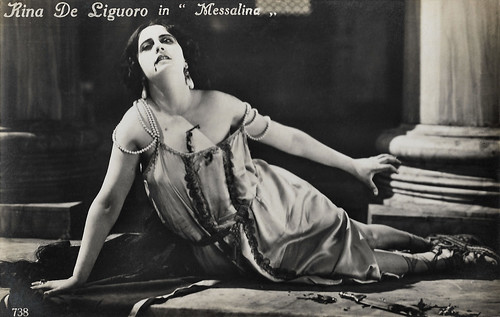
Italian postcard by Ed. A. Traldi, Milano, no. 738. Photo: Rina De Liguoro dying in the final scene of Messalina (Enrico Guazzoni, 1924).
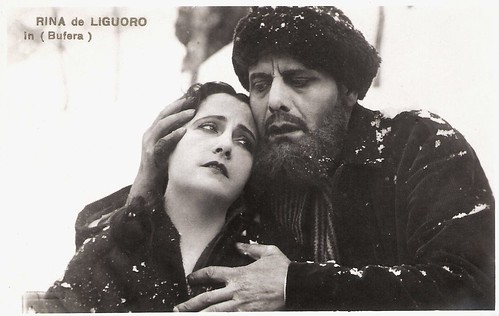
Italian postcard by G.B. Falci Editore, Milano, no. 393. Photo: Rina De Liguoro in Bufera/Storm (Wladimiro De Liguoro, 1926).
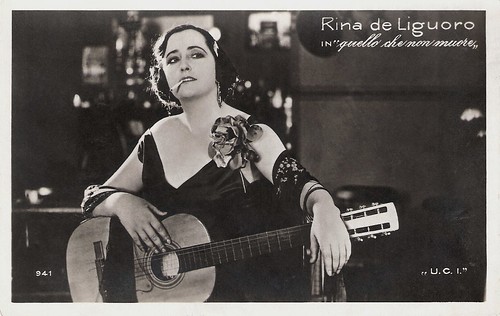
Italian postcard by G. Vettori, Bologna, no. 941. Photo: U.C.I. Publicity still for Quello che non muore/What does not die (Wladimiro De Liguoro, 1926).

Italian postcard by Ed. A. Traldi, Milano, no. 882. Photo: Pinto, Roma.
Laurel & Hardy
In 1930, Rina De Liguoro was invited to go to Hollywood. As Countess De Liguoro, she appeared in films like the box office success Romance (Clarence Brown, 1930) starring Greta Garbo and the flop Madam Satan (Cecil B. DeMille, 1930). Wikipedia about the latter: "Madam Satan has been called one of the oddest films DeMille made and certainly one of the oddest MGM made during its 'golden age.' The film originally featured Technicolor sequences that are now lost."
De Liguoro also acted in Spanish-language versions of American films, including Politiquerías (James W. Horne, 1931), the alternate language version of the Laurel & Hardy comedy Chickens Come Home (1931) in which she replaced Mae Busch.
But the silent cinema days were over and Rina De Liguoro could play only minor parts in Hollywood. She decided to try again a career as a piano player.
She returned to Italy in 1939. There she appeared in a few films, including Ritrovarsi/Lost and Found (Oreste Palella, 1947) and Buffalo Bill a Roma/Buffalo Bill in Rome (Giuseppe Accatino, 1949).
Her last role was that of Princess of Presicce, Burt Lancaster's table companion at the ball in Il Gattopardo/The Leopard (Luchino Visconti, 1963). Rina De Liguoro died in 1966 in Rome, Italy. She had demanded to be buried in her costume for Messalina.
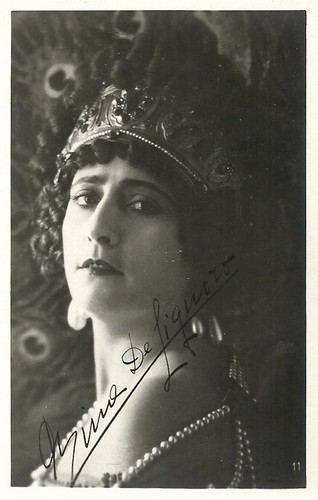
Italian postcard by B&G, B, no. 11. Signed Rina De Liguoro. Photo: Rina De Liguoro as the title character in the epic film Messalina (Enrico Guazzoni, 1924).

Italian postcard (reproduction). Photo: publicity still for Savitri Satyavan (Giorgio Mannini, 1925), according to Wikipedia 'India's first international co-production', with De Liguoro as the goddess Savitri.
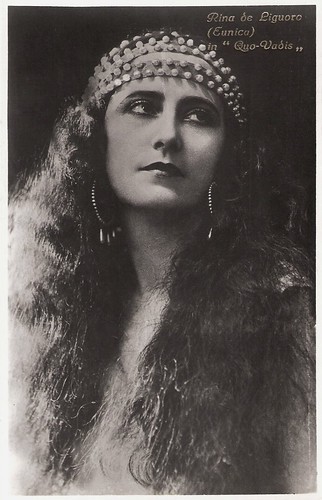
Italian postcard by G.B. Falci, Milano. Photo: still for Quo vadis? (1924).
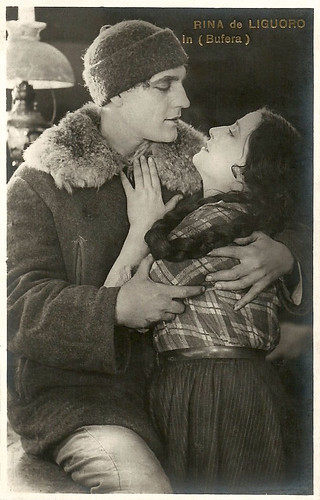
Italian postcard by Ed. G.B. Falci, Milano, no. 388. Photo: Rina De Liguoro and Celio Bucchi in Bufera/Storm (Wladimiro De Liguoro, 1926). Bufera is a mountain drama about a woman seduced and abandoned by a rude mountain man, leaving her with a child. When finally her life seems to retake thanks to another, kinder man, the first one reappears. Luckily a mountain storm (hence the title of the film) will swallow the inconvenient intruder.

Italian postcard by Ed. A. Traldi, Milano, no. 865. Photo: Pinto, Roma. Rina De Liguoro as Anita Garibaldi in Anita/Il romanzo d'amore dell'eroe dei due mondi (Aldo De Benedetti, 1926).
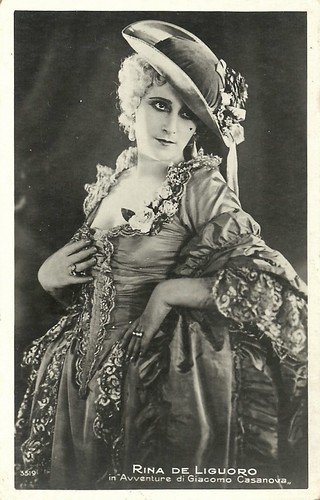
Italian postcard, no. 3519. Photo: Rina De Liguoro as Corticelli in Casanova (Alexandre Volkoff, 1927).

Italian postcard by Ed. Vettori, Bologna, no. 3522. Photo: Rina De Liguoro and Ivan Mozzhukhin in Casanova (Alexandre Volkoff, 1927).
Sources: Vittorio Martinelli (Le dive del silenzio - Italian), Hans J. Wollstein (AllMovie - Page is now defunct), Cristiano Ruggero (Find A Grave), Thomas Staedeli (Cyranos), Wikipedia and IMDb.
This post was last updated on 22 March 2025.
No comments:
Post a Comment